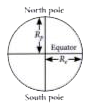Keeping the density of the earth constant, if the radius of the earth decreases by 2% , what would be the change in ‘g.?
Relation between acceleration due to gravity g and radius of earth (R) in terms of density is g=43πGρ.R
When density is kept constant and radius is decreased by 2% then ΔRR×100=2
from distribution of errors in multiplications and divisions Δgg×100=ΔRR×100=2%
When density is constant and radius of earth decreases by 2% then decrease in g value is also 2%.
Topper's Solved these Questions
- GRAVITATIONBOOK - AAKASH SERIESCHAPTER - GRAVITATIONEXERCISE - NUMERICAL EXERCISE (LEVEL - 1)
19 Videos
- GRAVITATIONBOOK - AAKASH SERIESCHAPTER - GRAVITATIONEXERCISE - NUMERICAL EXERCISE (LEVEL - 2)
8 Videos
- GRAVITATIONBOOK - AAKASH SERIESCHAPTER - GRAVITATIONEXERCISE - Practice Exercise
56 Videos
- GAUSS.S LAW BOOK - AAKASH SERIESCHAPTER - GAUSS.S LAW EXERCISE - PROBLEMS (LEVEL - II)
12 Videos
- GRAVITATIONALBOOK - AAKASH SERIESCHAPTER - GRAVITATIONALEXERCISE - EXERCISE -3
154 Videos
Similar Questions
Keeping mass unchanged if radius of the earth increases by a factor 4, then by which factor density must have to be changed so that the value of g remains same ?
View SolutionThe density of a newly discovered planet is twice that of earth. The acceleration due to gravity at the surface of the planet is equal to that at the surface of the earth. If the radius of the earth is R, the radius of the planet would be
View Solution
Knowledge Check
The Earth is not a perfect sphere. Due to the flattening of Earth at the poles, the radius of Earth is minimum at the poles and hence the value of g is maximum at the poles. One the other hand, the radius of the Earth is maximum at the equator of the Earth. As the mass and radius of moon are smaller than that of the Earth, so the value of g on moon is 1.63m/s2 . As we go up from the surface of the Earth, the distance from the centre of the Earth increases and hence the value of g decreases. The value of g decreases as we go down inside the Earth and it become zero at the centre of the Earth .

If the radius of the Earth were to shrink by 1% and its mass remaining the same, the acceleration due to gravity on the Earth's surface wouldAdecreasesBincreasesCremain unchangedDwill decrease by 9.8%The density of a newly discovered planet is twice that of earth. The acceleration due to gravity at the surface of the planet is equal to that at the surface of the earth. If the radius of the earth is R, the radius of the planet would be
A2RB4RC14RD12RLet g be the acceleration due to gravity at the earth's surface and K the rotational kinetic energy of the earth. Suppose the earth's radius decreases by 2%. Keeping all other quantities constant, then
Ag increases by 2% and K increases by 2%Bg increases by 4% and K increases by 4%Cg decreases by 4% and K decreases by 2%Dg decreases by 2% and K decreases by 4%
Let g be the acceleration due to gravity at the earth's surface and K the rotational kinetic energy of the earth. Suppose the earth's radius decreases by 2%. Keeping all other quantities constant, then
View SolutionLet g be the acceleration due to gravity at the earth's surface and K the rotational kinetic energy of the earth. Suppose the earth's radius decreases by 2%. Keeping all other quantities constant, then
View SolutionAcceleration due to gravity on the surface of the earth is g=GMR2. The gravitational constant G is exacity known. But percentage error in measurement of the mass of earth M and radius of the earth R are 1% and 2%, respectively. The maximum percentage error in measurement of acceleration due to gravity on the surface of the earth is
View SolutionIf the radius of the earth decreases by 20% such that mass does not change, then the length of the new day would be
View SolutionThe density of a newly discovered planet is twice that of the earth. The acceleration due to gravity at the surface of the planet is equal to that at the surface of the earth. If the radius of the earth be R, then radius of the planet would be
View Solution
